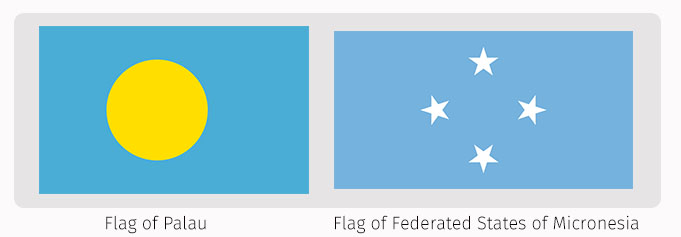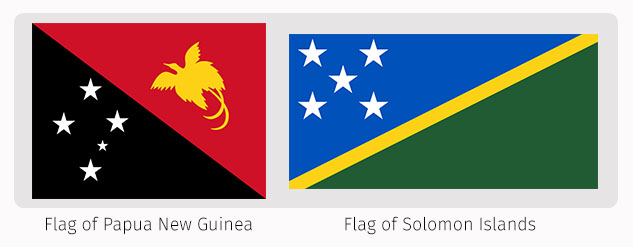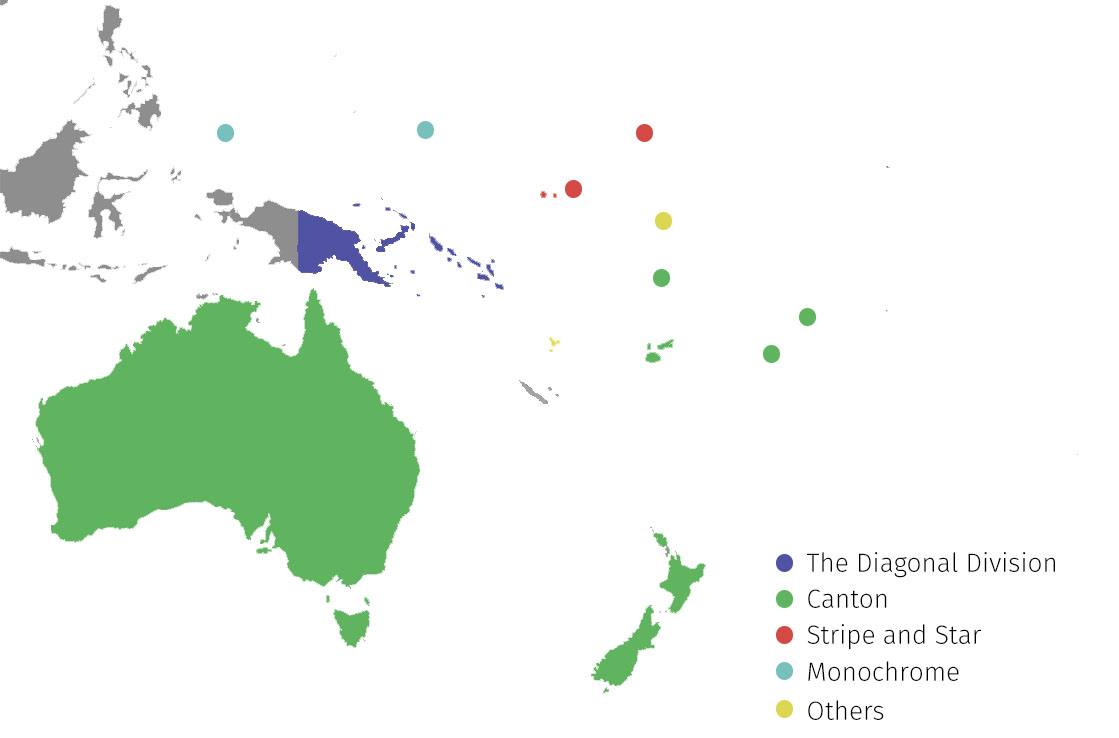Polybius wrote: “The natural properties of all nations inevitably form depending on the climate. For this and not for any other reason, nations have such sharp differences in character, body structure and skin color, as well as in most occupations.” I think cultural features can also be added here and also their ideas about aesthetics, beauty and art. This can be proven by a natural difference in trends of flag design in different parts of the world: Asia, Africa and Europe. Therefore, I propose to draw attention to the peculiar world of Oceania flags and segment this part of the world by flag types — what we have already done in the previous materials.

The traditional division of Oceania into regions
The accepted division of Oceania is based rather on the geographic location of the islands of this part of the world. Will the traditional map and the Oceania maps flag have large differences? Let’s find out.
Upper Canton
The first flag group stands out on the basis of a fairly obvious attribute — a square in the upper left part of the flag or in other words a canton. In the case of Australia (there is also a lower canton in the form of the Commonwealth Star), New Zealand, Tuvalu and Fiji it is a flag of the United Kingdom (Union Jack), which of course is connected with the colonial influence of this country on the region.
In the past, Samoa also used the British canton on their flag but since 1948 the Independent State of Samoa changed it to the Southern Cross which is a popular symbol in the flags of the region. This constellation can actually be observed in this part of the world.
Regarding the Tonga flag it did not change even during the dependency on the UK and the constitution of Tonga says that it should never be changed. The red color symbolizes Christianity (or the blood of Jesus Christ) as it is the dominant religion of the state and white represents the purity of the nation.
The nine stars on the Tuvalu flag symbolize nine coral islands (also called atolls) and correspond to their location on the map. Fiji flag has the coat of arms with the Cross of St. George and the blue color on the flags of these states represents the color of the ocean.

Flags using the upper canton
Monochrome
The color of the flags of Palau and the Federated States of Micronesia also symbolize the blue ocean. The similarity of the Palau’s flag with the flags of Japan and Bangladesh is not accidental as the Japanese flag was taken as the basis for the development of the Palau’s and the yellow circle in this case symbolizes not the rising Sun but a full Moon which indicates the time that is suitable for fishing, tree felling and harvesting. The flag of Micronesia shows four stars — the four states (island groups) of FSM.

Monochrome flags
Stripe and Stars
Twelve points of the star on the Nauru flag represent the twelve tribes and the position of the star shows the location of the country in the relation to the equator — the yellow stripe. Twenty-four pointed star of the Marshall Islands symbolizes the number of constituencies, stripes — the equator, where the orange and white stripes are two island chains — Ralik (sunset) and Ratak (sunrise) respectively.

Flags with stripe and stars
The Diagonal Division
The colors of the Papua New Guinea (PNG) flag are similar to the German Empire flag as PNG is a former German colony. But the black and red colors in general are part of the Papuans culture. On the black part of the flag a typical asterism of that region is present and the bird-of-paradise on the red part is endemic to the New Guinea and the surrounding smaller islands.
Five groups of the Solomon Islands are reflected on the flag with five stars. The light blue part of the flag symbolizes the ocean, green — vegetation on the land and the yellow dividing line — the Sun’s rays or the sunrise.

The Diagonal Division
Others
Three white stripes on the flag of Kiribati display three island groups of the country, and the seventeen rays of the Sun — the islands themselves. Frigate bird symbolizes freedom and the national dance. The color of the Vanuatu flag matches the color of the Vanuaku party (green — islands, black — the population, red — blood) due to which the state gained independence. Yellow is the color that reflects the light of the Gospel (the dominant religion of the country is Christianity). The yellow boar’s tusk is the symbol of prosperity worn as a talisman on the islands and two leaves of the local namele fern. The leaves are a symbol of peace and 39 of their leaflets represent 39 members of the Vanuatu’s parliament.

Others
All flags of Oceania have a quite specific structure. Despite the fewness of colors and some predisposition towards monocolors, Oceania flags fully reflect the island life of the peoples of the region: an overwhelming usage of light and dark blue colors representing the ocean, the love for the stars and celestial symbols, birds and religion.
The Southern Cross constellation which is observed in the southern hemisphere is used by the four states of the Oceania and also many dependent territories and some states of other parts of the world. It is noteworthy that this is the smallest constellation of all 88, in spite of this the Southern Cross is important for the navigation. And on 1 August 2012 the Royal Australian Mint has released a coin with the image of the Southern Cross which shows the coordinates of the constellation.

Southern Cross in the sky above Mauna Loa (Hawaii, USA)

Southern Cross coin from the Southern Sky series
Let’s take a look at the map of Oceania, which is to say has a very intuitively correct division. Thus, islands are segmented into clear geographical groups and due to the fact that these groups do not overlap they can be freely divided on the basis of the type of flag.

Map of Oceania (islands which are too small for this scale are shows by circles)



























Comments